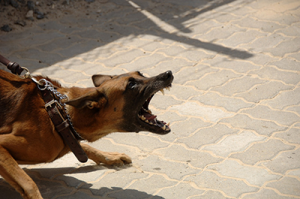Working in the security system industry under the name of Rottweiler Systems we see a lot of comments, such as:

We, at Rottweiler, wanted to take some time to address the idea that a dog is an appropriate substitute for an alarm system.
The Family Dog

While we all love and cherish our furry friends, it is important to distinguish between a dog and a guard/attack dog. Most dogs react to visitors to your home in the same way whether you are there or not. If your pooch is a friendly fellow he or she will approach with tail wagging, hoping for a pat on the head. If you have a more nervous dog it is more likely they will stand back, constantly retreating from whatever is approaching them. If you thought your dog only liked the cookies you pass their way – think again – a bone is a bone and will occupy your little pooch for quite a while, giving the intruder plenty of time to grab valuables. Even if your German Shepard is aggressive to visitors, most thieves know ways to distract dogs or enter through areas where the dog cannot get to. For instance, if you lock your bedroom door to keep a Rover from jumping on your bed while you are away, you're leaving those valuables unprotected.
Dog owners know the love and affection that a dog can bring to the family. As the owner of an American Bulldog, I can attest that her slobbering face brings warmth to my heart. This being said I operate under no misconception that she would attack an intruder. She has not been trained to attack on command or in defense, and so I would not want her to be aggressive to anyone (human or otherwise). Every dog owner should share this mentality. Trained attack dogs cost so much because the training that is required to keep them loyal and loving, while still attacking on command, is extremely intensive.
Guard Dog vs. Attack Dog
According to PetMD, guard dogs are trained to alert an owner of a stranger’s presence. These are not “attack dogs” because are not trained to attack an intruder, merely make a lot of noise. They include Shar-Peis, Pugs, Chow Chows, and Chihuahuas. While a dog is an excellent deterrent for many burglars, it will not always dissuade all of them. Most robbers are aware that not all noisy dogs are dangerous. Even more know that bedroom doors are usually shut and so the point of entry is simple to check.
Now let’s talk about trained attack dogs. These dogs can range from $2,500.00 - $25,000.00 depending on the breed, training, history, and age. These dogs have gone through hours of training and been taught to recognize their trainers. Then the trainers will retrain the dog – and you – so that he or she will trust you as the new owner.

Most attack dogs are trained for use by police officers in K9 units and the military as sentry posts. The most common attack dogs include German Shepherds, Belgian Malinois, Rottweilers, Bullmastiffs, American Bulldogs, American Pit Bull Terriers, and Doberman Pinschers. Lesser known breeds were used in WWII, such as Belgian Sheepdogs and Farm Collies. It is important to understand that the best attack dogs are highly socialized, loyal, and unerringly obedient. These dogs have spent hours being trained. These dogs will not attack unless their owners are facing attack or have commanded the dogs to attack. Furthermore, these loyal dogs will stop attacking on command.
While you may believe that the trainer is upfront with you, it is important that you are sure that the dog is properly trained. These dogs should not attack unsuspecting people without warning or cause. The danger is that the previous owner has trained the dog to fight rather than to attack on command. This would make the animal a danger to itself, its family, and those around it. Keep in mind that some of the best attack breeds, even when properly trained, can be banned in some areas or require surveillance cameras for insurance because of those that have caused harm to people without provocation.
Why Untrained Attack Dogs Cause More Pain Than Protection
Now that we have some basic definitions in place for guard and attack dogs let’s talk about what a dog should not do. A dog should never attack if the owner is not in harm’s way or has not commanded the attack. A dog that does attack without provocation is an uncontrollable and potentially dangerous animal. In 2015, 34 dog-related fatalities occurred and 82% of those were children under the age of nine. An additional 32% were house guests or visitors to the dog owner's house. A violent and untrained dog can quickly turn a welcomed visitor into another statistic. This is why comments about Rottweilers or German shepherds providing home protection are so misleading. The public should be educated that a dog that will attack an intruder is just as likely to attack a visitor since they have not been properly socialized and trained. Furthermore, since a dog that attacks on his or her own consider the home to be its territory, it has assumed the alpha role. Everyone living on the property is at risk. In 2010, 65% of burglaries involved perpetrators and victims that knew each other. You’re playing Russian Roulette if a dog, inclined to attack visitors that it knows, is your sole security defense.
The Reason for a Security System
Understanding why the family dog is not the solution to a home invasion is critical. While a well-trained attack dog will protect you while you are home, what if your family is away? What if you are on vacation and the dog is with you or in a kennel? Who or what is protecting your home? A security system can be the best answer, and for those that don’t want to fork out the several thousand dollars a great attack dog will cost – in addition to the veterinary bills, food, and other expenses – it can be a cost-effective solution. A simple alarm system that is properly installed and configured will alert the police within seconds of an alarm being triggered. Homes without a security system are 300% more likely to be burglarized. In addition, insurance companies offer up to a 20% discount with a security system, while an attack dog usually raises insurance rates.
High-quality surveillance camera integration can help catch potential burglars – another thing that Fido won’t help much with. When you invest in a surveillance system that takes high-resolution video you are more likely to be able to gauge the invaders height, build, completion, and other physical attributes. Analytic cameras can track when a certain area has seen movement, so you can be alerted before the attempted break-in occurs. It’s like a guard dog that doesn’t need food, water, or sleep.
When Rottweiler Systems installs a security system we incorporate carbon monoxide and smoke detectors into the system. Since dogs can just as easily suffer from carbon monoxide poisoning as humans, the family pet rarely will signal that something is wrong. Additional things that Rover won’t be able to help you out with (unless you’re an amazing trainer, of course) is automated blinds, lights, garage doors, and thermostats. Oh, and did we mention that with a surveillance system you can check in on your pets throughout the day? Finally, you’ll know what that pesky feline or guilty looking pup has been up to while you were away.
In Conclusion

Now that you understand the difference between the family pet, a guard dog, an attack dog, and an integrated security system; we hope you realize the added value that comes with a security system. It gives you real-time information that you can use to protect your property and family. It can help catch a bad guy, even if he wasn’t caught in the act or he fled the scene before taking any property. It can protect your home while you’re at work, out for the night, or on vacation. There is one other thing that your security system can help you keep an eye on and protect: your furry, four-pawed, family members! We all love our pets, so why would you rely on them to protect you when you can protect them with a Rottweiler Security system!


